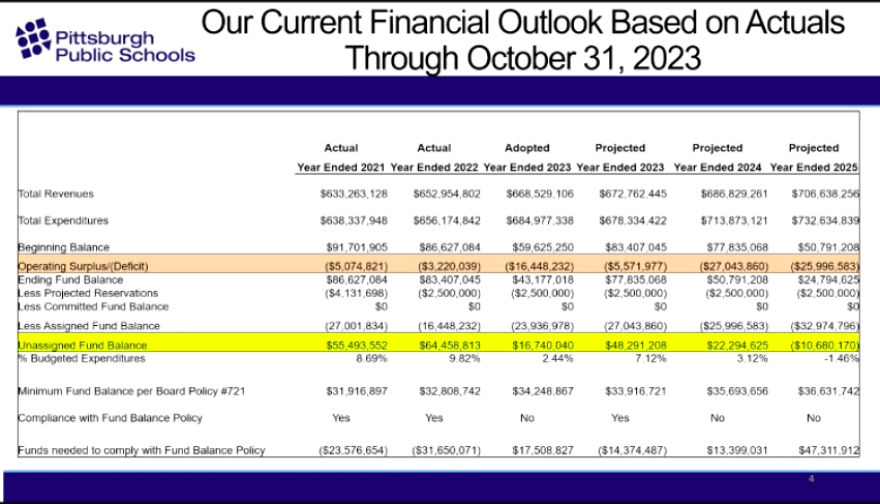Pittsburgh Public Schools (PPS) is finalizing a $713.9 million budget for 2024, including a roughly $29 million operating deficit.
About 42% of all expenditures would be allocated to mandated costs the district doesn’t have control over, according to PPS chief financial officer Ron Joseph. That includes $40.8 million to cover the district’s debt service, $92.3 million for special education and $144.7 million in charter tuition payments.
Pennsylvania law requires school districts to pay tuition for local students who attend charter schools. At PPS, that cost alone increased by close to $24 million over the past year. It accounts for 20% of the district’s total planned spending.
Charter tuition is the second largest of the district’s planned expenditures, behind salaries and benefits. Those items total $338.8 million — 47% of the entire proposal.
“We have a lot of factors that are affecting our bottom line,” Joseph said during a budget workshop Tuesday. “We weren’t in a good position in previous years, and we’re not in a good position this year.”
The district last raised taxes in 2022, and like last year, doesn’t plan to do so again. The budget projects $684.3 million in revenues, 54.6% of which comes from local revenue sources — namely real estate taxes and earned income tax.
Budgeted real estate collections are down by close to $3.5 million compared to last year’s budget, the result of changes to the Common Level Ratio, the calculation used in county property assessments.
District solicitor Ira Weiss said that unless the county is willing to consider a countywide reassessment, administrators should expect to see continued reductions in its tax collections.
The district’s earned income tax revenue for 2024, meanwhile, is expected to increase by approximately 4.7% to $166.9 million. The district levies earned income tax on city residents, though some $23 million of that is diverted each year to the City of Pittsburgh.
The diversion dates back to 2004, when state legislators reallocated some of the school district’s revenue to help Pittsburgh avert financial collapse. Weiss said that practice will continue indefinitely — even with Pittsburgh in a financially healthier place — unless the state amends the law or the city willingly gives it back.

To make ends meet amid shifting local revenues, administrators have proposed lifting $29.6 million from the district’s fund balance to cover the projected operating deficit.
Forecasting based on the district’s October financial picture projects that doing so would leave $22 million in its unassigned fund balance, or just 3.1% of budgeted expenditures. That means the budget falls out of compliance with the district’s fund balance policy, which requires the district to have at least the equivalent of 5% of budgeted expenditures in its fund balance at all times.
Dropping the fund balance to cover the 2024 operating deficit would set the district up for a $10.7 million budget shortfall come 2025, unless changes are made.
Joseph told school board members that the district must begin to course correct, especially as enrollment continues to decline.
“Not saying that school closures is the end all be all, but we have to look at ways that we can make sure that we're adjusting our operations to the size of the population that we’re currently serving,” Joseph said.
Pittsburgh schools operate at just 54% of their capacity, according to a presentation Tuesday by the district’s facilities division, and nearly 17,000 seats are empty.
Seven-year capital plan includes air conditioning installations in at least 14 schools
The district enrolled approximately 17,987 K-12 students this school year, down from 21,919 during the 2018-2019 school year, and early enrollment projections included in the budget don’t show any signs of that decline slowing down: PPS is expected to enroll just over 14,443 kids by 2030.
PPS still owns and maintains four of the schools it closed down in light of demographic shifts over the past two decades: Fort Pitt, Bon Air, Northview, and Knoxville, which is now a district storage facility.
They’re an added cost for PPS, which faces an ever-increasing deferred maintenance backlog. The operating budget was paired with a $40 million capital plan for 2024, including air conditioning installations in some of the 37 district buildings that lack sufficient cooling systems.
Dozens of schools switched to remote learning during heat waves in June and September. HVAC updates at all of the schools that need it would require between at least $443 million, and at most $553.6 million.
The $362 million capital plan through 2030 — also presented to board members Tuesday — includes air conditioning installations and ventilation updates at 14 district schools, though much of that work isn’t scheduled to begin until after 2026.
The school board will hold its third and final budget workshop Wednesday evening. A special public hearing on its proposal will be held at noon on Monday, Dec. 4.





